Archaeological and forensic detective
work lead to the remains of Ned Kelly, one
of Australia's most celebrated, reviled,
and polarizing historical figures
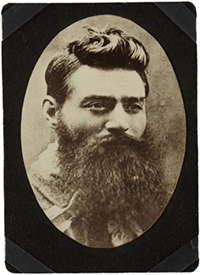
Edward "Ned" Kelly, Australia's most notorious bushranger
and outlaw, sat for a portrait the day before his
execution in 1880. (Courtesy State Library of Victoria)
 Anatomy of a Shootout
Anatomy of a Shootout
In the photo taken the day before he
was hanged in November 1880, Ned
Kelly's eyes are fixed in a firm, defiant
gaze. Though much of his face
is hidden beneath a thick beard, it
is possible that a little smile plays
about his lips. But it's hard to tell for sure.
Kelly is one of the most iconic and polarizing figures
in Australian history. He is the most famed of the
guerilla bandits known as bushrangers, some of whom,
in their day, personified revolt against the colony's
convict system ("Australia's Shackled Pioneers," July/
August 2011) and against the excesses of wealth and
authority. There's no real non-Australian analogue
for Kelly—he was part Clyde Barrow, part Jesse James,
part Robin Hood, but with media savvy and a strong
political sense. To some, particularly Australians of Irish
descent, he's a populist hero. To many others, he's a
cop-killer, and his lionization is distasteful at best. He
is, at the very least, an enduring subject of fascination.
For all that is known about his life and the crime spree that
ensured his immortality, theories have long abounded about
what happened to Kelly's remains after his execution. "Whilst
he was an outlaw, there's a lot of interest in how he was treated by the police, the courts, and judicial systems,"
says David Ranson, a pathologist at the Victorian
Institute of Forensic Medicine. In the place
of certainty, there was rumor, supposition,
and endless questions. Had his skeleton
been taken apart by trophy hunters? Was
his skull put on display and then stolen in
the 1970s? Had doctors conducted a clandestine autopsy and taken his remains away for study? It has taken
a decade of archaeological, forensic, and historical sleuthing
to understand the convoluted story of Kelly's remains—and
those of more than 40 other executed criminals—and learn
that everything we thought we knew about that history was
wrong. Finally, many of the mysteries surrounding Kelly's bones
can be laid to rest. But not all of them.
In 1929, construction had begun on a school that would
become the Royal Melbourne Institute of Technology
(RMIT) at the site of the recently closed Old Melbourne
Gaol. It was known that around 30 executed criminals had been
buried there between 1880 and 1924. The graves were located
in a long, narrow yard at the base of a wall that held markers for
each burial, including one grave marked "E.K." with an English
broad arrow, signifying the grave of Edward "Ned" Kelly. The
construction workers expressed misgivings about digging through
a graveyard, but were told that the remains had been covered with
quicklime and would have disintegrated. Even though some of
the remains had been in the ground for only a few years, workers
were still shocked when bodies started turning up.
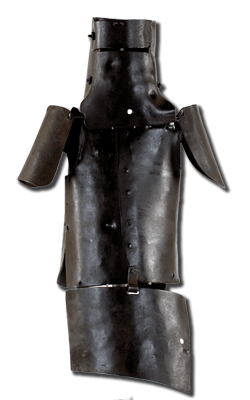
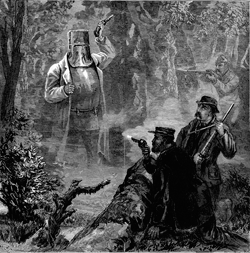
His most audacious and iconic moment
came during his final shootout, when he donned makeshift
metal armor (top) and attempted to flank the police. (Courtesy State Library of Victoria)
Plans were made to exhume and rebury the bodies at Pentridge
Prison, about five miles away. On April 12, 1929, the
first graves were opened, including the one thought to contain
Kelly. Onlookers were seized with desire for a souvenir from
the great outlaw. "As soon as this gruesome discovery was made a crowd of boys who had been standing around expectantly
while eating their luncheons rushed forward and seized the
bones," read a story in the newspaper the next day. Authorities
retrieved most of the bones that were taken, reports said, but
the process can charitably be described as disorganized. The
remains in the graveyard were moved to a series of mass graves
at Pentridge in 1929 and, in 1937, four more were relocated
there from the jail's hospital grounds.
In 2002, archaeologists from La Trobe University were monitoring
landscaping work at RMIT when they were surprised to
find a grave—one had apparently been missed in 1937. Archaeologists
believe this was the only body that had been left behind. But they also knew the reburial of the others had been haphazard,
leading them to speculate whether these remains moved from
the old jail were where they were supposed to be—including the
remains of Kelly, if there were any left. Pentridge, where they were
reburied, was used as a prison from the 1850s until 1997, but the
precise location and layout of the cemetery within its sprawling
grounds had been forgotten, and the government had recently
sold portions of the site to private developers.
"We decided we really needed to be confident that we knew
everything about [Pentridge]—particularly about its archaeology,
and particularly about the burials," says Jeremy Smith, an
archaeologist at Heritage Victoria, the state's historical authority,
which oversaw a series of excavations there between 2006 and
2009. Somewhere at this site, unmarked amid the remains of
dozens of other criminals, might be the remains of Kelly himself.
Ned Kelly was born in Beveridge, north of Melbourne,
in 1855, the son of an Irish convict. Young Kelly ran
afoul of the law throughout his teens, but his bushranging
career didn't really begin until April 1878, when a constable
arrived at the family home to arrest Ned's brother Dan, and
afterward claimed that the Kelly family had attacked him. The
brothers, who denied the accusation, took to the bush. Their
mother, Ellen, was charged with attempted murder for the incident
and sentenced to three years, fueling Ned's hatred of the
police and distrust of government. Ned and Dan joined up with
friends Joe Byrne and Steve Hart, forming the Kelly gang, which
consistently tried to one-up itself over the next 21 months.
In October 1878, Ned killed three constables at Stringybark
Creek. The reward for the gang's capture went from £100 to
£500 per man, dead or alive. In December, they took 22 hostages
at a sheep station and then robbed the National Bank in
Euroa of £2,000. The reward doubled. In February 1879, the
gang took over a police station in Jerilderie, locking up two officers
while they robbed the Bank of New South Wales (wearing
police uniforms) of another £2,141 pounds, after which they
rounded up 60 people at the Royal Hotel next door. There, Ned
dictated a fiery, quasi-political, 8,000-word manifesto about his
Irish roots and the injustice of the courts and convict system.
The reward was doubled again and Aboriginal trackers were
brought in to find them. In late June 1880, the gang took over
the Ann Jones Inn in Glenrowan (see "Anatomy of a Shootout,"
page 31), holding another 60 people hostage, and attempted to
derail a special police train sent to bring them in. Surrounded
by police at the inn, the gang donned armor made from metal
plows. Ned fled the hotel and flanked the cops, coming out of
the shadows in his mailbox-like, but no less intimidating for
it, armor. His legs weren't protected, so Ned was taken down
with low shots. In the hotel, Byrne was killed in the shootout
and Dan Kelly and Hart took poison before the police set fire
to the building. On November 11, 1880, Ned, the last surviving
member of the gang, was hanged at Old Melbourne Gaol.
Reportedly, 8,000 fans and sympathizers turned out at a rally
for his reprieve. His last words are said to have been, "Ah well, it
has come to this." It's the stuff of legends. (And movies—both
Mick Jagger and Heath Ledger played him on screen.)
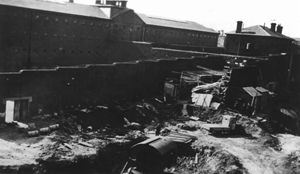
During construction at the Old Melbourne Gaol in 1929
workers uncovered the bodies of some 30 executed criminals,
including Kelly's, which were then relocated to nearby
Pentridge Prison. (Courtesy RMIT University)
According to historical records, 44 bodies had
been buried at Pentridge—30 moved there in 1929,
another four in 1937, and 10 prisoners executed at
Pentridge between 1932 and 1967. One version of the Pentridge
cemetery plan showed that the remains moved in 1929
were buried in three mass graves, but wasn't clear on where
they were actually located.
In 2006, Heritage Victoria had private company Terra Culture
conduct test excavations at what was thought to have been
Pentridge's cemetery, but they found only one set of remains—
those of Ronald Ryan, the last man to be executed there in 1967.
"I remember thinking that day," says Heritage Victoria's Smith,
"we've got more than 40 bodies unaccounted for, including some
of the most notorious and infamous Australians that there are,
including the most famous of all Australians, Ned Kelly."
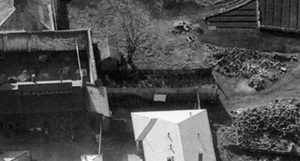
A 1955 aerial photo was used to locate
mass graves containing
the remains of Kelly
and more than 40 other
executed criminals. (Courtesy State Library of Victoria)
The team then found a 1955 aerial photograph that showed
a rectangular, overgrown, fenced yard that appeared to match
the dimensions of the cemetery plan. Archaeologists found the
area muddy, covered in weeds, and surrounded by the prison's
massive, intimidating bluestone buildings. "As an archaeological
site, it's quite unusual. It almost had echoes of a Bronze Age site.
You had these large monolithic structures looming over these
equally large open areas," says Smith. "It still very much had
that sense of isolation and remoteness even though it's only 10
kilometers [six miles] from the center of Melbourne."
The excavations first uncovered the more recent graves, and
later located two of the three mass graves from 1929—roughly
where the plan indicated they might be. But the last and largest
of the mass graves, containing the remains of 15 more men,
probably including Kelly, was not where the plan indicated. In
February 2009, the owners of the site phoned Heritage Victoria
to say they had uncovered a deeply buried box. Archaeologists investigated and found the third mass grave, 100 feet from where
it was indicated on the plan. It contained two layers of burials,
with 24 coffins and boxes that held the remains of 15 men (some
spread across multiple boxes). It is thought it might have been
relocated—without documentation—during drainage work in the
1960s. Somewhere among this jumble of bones and boxes may
have been evidence of Ned Kelly himself. "Kelly's important," says
Smith. "If it wasn't for the notoriety, the significance, the profile
of Ned Kelly, probably the project would have trickled along."
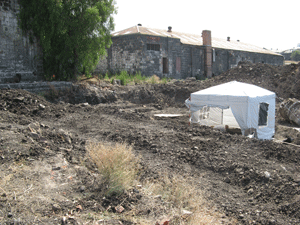
The site was excavated between 2006
and 2009. (Courtesy Heritage Victoria)
Most unidentified human remains in Australia
go to the coroner, who must determine whether an
inquest is required. With so many sets of remains, an
inquest would have been lengthy and costly, so it was incumbent
on the archaeologists to establish a clear history of the site.
"It was all about demonstrating to the coroner, through the
archaeological processes, that we were confident that these were
late-nineteenth-century executions that had been done as part
of the judicial process, and that the stratigraphy showed no signs
of recent disturbance," says Smith.
The oldest remains were sent to the coroner at the Victorian
Institute of Forensic Medicine (VIFM). "This is a very
unusual case. It was old skeletal remains and they are difficult
to examine, but in addition, there was a very large amount of
historic interest among the general public and also at a political
level," says Fiona Leahy, Senior Medico-Legal Officer at VIFM.
While the excavations were taking place and the remains were
being examined by forensic pathologists, anthropologists, and
odontologists, another mystery was unfolding. "We had the
long-standing, quite interesting, scandalous story of the alleged
Ned Kelly skull," says VIFM pathologist David Ranson.

The remains of executed criminals from the Old Melbourne
Gaol were relocated to Pentridge Prison in 1929 and 1937,
and then exhumed from 2006 to 2009. In one grave, 15 men,
including Kelly, had been haphazardly reburied in 24 coffins
and boxes. (Courtesy Heritage Victoria)
In 2008, Heritage Victoria reached out to a man named
Tom Baxter who claimed to know the whereabouts of Kelly's
skull. A complete cranium thought to be Kelly's had a long and
checkered history. This skull was apparently not reinterred at
Pentridge, but was given to government officials and then passed to Colin Mackenzie, first director of the Australian Institute of
Anatomy in Canberra. The institute made a cast of the skull,
and eventually turned it over to the National Trust in 1972,
which put it on display in the museum of the Old Melbourne
Gaol, next to a Kelly death mask (a postmortem plaster cast).
This skull, which had been labeled "E. Kelly" at some point in
its history, was stolen in 1978.
Baxter, without saying how he came into possession of it,
agreed to return the skull on November 11, 2009, 129 years to
the day after Kelly's execution. With it in their possession, the
experts at VIFM had any number of questions, and a sophisticated
arsenal of techniques by which to answer them. Was this
the skull held at the Institute of Anatomy? Was it the one on
display and stolen from the Old Melbourne Gaol? And, perhaps
most importantly, was it Kelly's?
Researchers at the VIFM took photographs, X-rays, and CT
scans, and conducted craniofacial superimposition—layering the
new images of the skull over the replica made at the Institute of
Anatomy and photos of it on
display later at the old jail. All
the images matched up. They
also located a tooth—kept by
the grandson of a workman
present at the 1929 exhumation—
and it fit perfectly. The
pathologists then superimposed
the CT scan of the skull
over CT scans of death masks
from the executed men.
While this process cannot
provide conclusive evidence,
and not all the executed prisoners
had death masks, it
helped reduce the number
of possible candidates. These
comparisons eliminated all
but two men: Frederick Deeming, a serial killer who was suspected
of having been Jack the Ripper, and Ned Kelly.
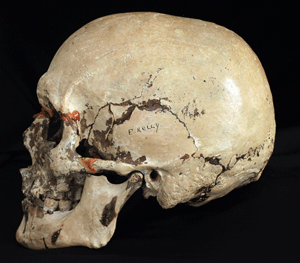
A skull labeled "E. Kelly" was
thought to have belonged
to the notorious bushranger.
Examination and DNA testing
revealed that it was not his—
leaving open questions about
the fate of Kelly's cranium. (Courtesy Victorian Institute of Forensic Medicine)
By September 2010, the coroner had determined no inquest
was necessary. The VIFM, working with the experienced Argentine
Forensic Anthropology Team, subjected the left clavicles
from 30 sets of remains from the mass graves to mitochondrial
DNA (mtDNA) testing. The Baxter skull was also tested, as was
a sample from the living great-grandson of Kelly's sister. "It's
about delivering certainty," says Smith.
The mtDNA from the surviving Kelly ancestor was a match
to a set of remains from the third pit—and not a match for the
Baxter skull. Surprisingly, the matching remains were among
the most complete of any of the Pentridge burials. They were
missing only a few cervical vertebrae, some small bones, and
the skull, except for a palm-sized fragment—further proof that
the intact Baxter skull could not have been Kelly's. "The Kelly
remains are almost complete. It's one of the best sets of remains
from the entire site. That I did not expect at all," says Smith.
"It contradicted the historical evidence that Kelly's burial had
been targeted by trophy collectors."
Closer examination of the bones showed unmistakable
evidence of Kelly's injuries from the shootout
at the Ann Jones Inn. Injuries to the top of the right
tibia, the left arm, and the right foot all matched
those documented by prison surgeon Andrew Shields
when he examined Kelly after arrest. Using an otoscope
and dental instruments, Ranson even removed
two lead pellets from the tibia. "We had genetic evidence
and a lot of anthropological evidence, and then
when we looked at the historical evidence as well, it
really tied it all together," says Soren Blau, the forensic
anthropologist who examined the remains. Smith
describes the outcome as "staggeringly conclusive."

DNA was used to identify the mostly complete skeleton of Ned Kelly. (Courtesy Victorian Institute of Forensic Medicine)
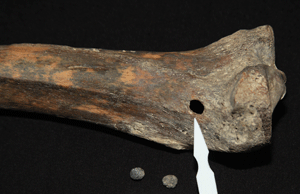
The remains included a bullet hole in the leg consistent with
his injuries. (Courtesy Victorian Institute of Forensic Medicine)
As for the Baxter skull, it actually matched
another set of remains, one that was in the fragmentary
condition that Smith expected of Kelly's.
A closer look at plans from the original cemetery at
the Old Melbourne Gaol suggests that Deeming—
whose death mask is consistent with the skull—may
have been buried close to Kelly. This raises the
possibility that the trophy seekers in 1929 simply
raided the wrong coffin. But without Deeming
family DNA, "we haven't been able to prove that
conclusively," says Leahy.
If the Baxter skull does not belong to Kelly,
and the mass grave contains only a palm-sized
fragment, what happened to the rest of Kelly's
head? A lurid account from 1880 refers to rumors that
Kelly's remains were dismembered and taken away by
"medical men" after execution. It is now known this
didn't happen, and it is also known that Kelly told the
prison surgeon Shields that he did not want his body
dissected. Helen Harris, a historian working with
the VIFM team, found evidence of a letter from the
prison governor, John Castieau, stating that there was no truth
to the dissection rumors. But Kelly's remains have a story of
their own to tell, somewhere between rumors and official record.
The skull fragment with the Kelly remains came from the back
of his cranium, and shows saw marks across the top and down the
sides. The cuts clearly continue on the cervical vertebrae below.
A physician had explored the remains of Kelly with more than
his eyes. In that era, authorities were concerned with whether
hanging was indeed an instantaneous, humane form of execution.
Hangings were known to have been botched, resulting in long,
drawn-out choking rather than death from a hangman's fracture—
a quick, decisive snap of the neck. "This piece of skull suggests
the individual had been subject to a limited autopsy, probably to
investigate the interior back half of the neck following an execution,"
says Blau. "That was probably not uncommon given that
there was interest in whether hangings were effective or not, and
it was important for the jail to say that it was a successful hanging."
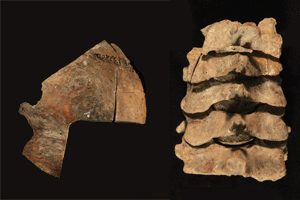
A fragment of skull (left) and several vertebrae (right) show evidence of saw marks, suggesting that Kelly's body had been
examined postmortem to determine the effectiveness of his hanging. (Courtesy Victorian Institute of Forensic Medicine)
It is impossible to say what became of the rest of Kelly's skull,
beyond the fact that any complete skull couldn't possibly belong
to him. "Unfortunately we only have part of the answer," says
Leahy. "It could be sitting in someone's garage or it could simply have gotten lost, discarded, or disintegrated. We don't know."
"The mystery continues," she adds. "What exactly happened
in the jail after his hanging has not been fully explained.
We have our theories."
And theories are the coin of the realm for a figure as nearmythic
as Kelly. The stories and speculation will continue—
some even refuse to believe the definitive findings from Heritage
Victoria and VIFM. Mythos notwithstanding, archaeology and
forensic work have provided knowledge about the end of Kelly's
life: The back of his skull was opened, he was buried at the Old
Melbourne Gaol, his grave was not looted, and his remains
were reburied at Pentridge Prison mostly intact. Almost all the
remains of the executed prisoners will be reburied again in an
official cemetery at Pentridge. But probably not Kelly's. Officials
are still trying to decide his final resting place.
"It's introduced certainty," says Smith, "into a project where
10 years ago everything we knew about this was wrong."
At press time, authorities were still undecided about the final resting
place of the remains of Ned Kelly. In early August 2012, it was determined
that they would be turned over to his descendants for burial.
For more information on Australia's convict period, go to
archive.archaeology.org/convict
Samir S. Patel is deputy editor at ARCHAEOLOGY.

